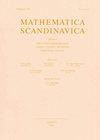大型水平集图像的尺寸
IF 0.7
4区 数学
Q4 MATHEMATICS
引用次数: 0
摘要
设$k$是一个自然数。我们考虑$k$-次连续可微实值函数$f\colonE\to\mathbb{R}$,其中$E$是具有正长度的线上的某个区间。对于$0<\alpha<1$,设$I_\alpha(f)$表示值$y\in\mathbb{R}$的集合,其前映像$f^{-1}(y)$具有至少$\alpha$的Hausdorff维数。我们考虑$I_\alpha(f)$的Hausdorff维数有多大,因为$f$在从$E$到$\mathbb{R}$的所有$k$次连续可微函数的集合上。我们证明了$\dim I_\alpha(f)$的尖锐上界是$(1-\alpha)/k$。本文章由计算机程序翻译,如有差异,请以英文原文为准。
Dimension of images of large level sets
Let $k$ be a natural number. We consider $k$-times continuously differentiable real-valued functions $f\colon E\to \mathbb{R} $, where $E$ is some interval on the line having positive length. For $0<\alpha <1$ let $I_\alpha (f)$ denote the set of values $y\in \mathbb{R} $ whose preimage $f^{-1}(y)$ has Hausdorff dimension at least $\alpha$. We consider how large can be the Hausdorff dimension of $I_\alpha (f)$, as $f$ ranges over the set of all $k$-times continuously differentiable functions from $E$ into $\mathbb{R} $. We show that the sharp upper bound on $\dim I_\alpha (f)$ is $(1-\alpha )/k$.
求助全文
通过发布文献求助,成功后即可免费获取论文全文。
去求助
来源期刊

Mathematica Scandinavica
数学-数学
CiteScore
0.60
自引率
0.00%
发文量
19
审稿时长
>12 weeks
期刊介绍:
Mathematica Scandinavica is a peer-reviewed journal in mathematics that has been published regularly since 1953. Mathematica Scandinavica is run on a non-profit basis by the five mathematical societies in Scandinavia. It is the aim of the journal to publish high quality mathematical articles of moderate length.
Mathematica Scandinavica publishes about 640 pages per year. For 2020, these will be published as one volume consisting of 3 issues (of 160, 240 and 240 pages, respectively), enabling a slight increase in article pages compared to previous years. The journal aims to publish the first issue by the end of March. Subsequent issues will follow at intervals of approximately 4 months.
All back volumes are available in paper and online from 1953. There is free access to online articles more than five years old.
 求助内容:
求助内容: 应助结果提醒方式:
应助结果提醒方式:


